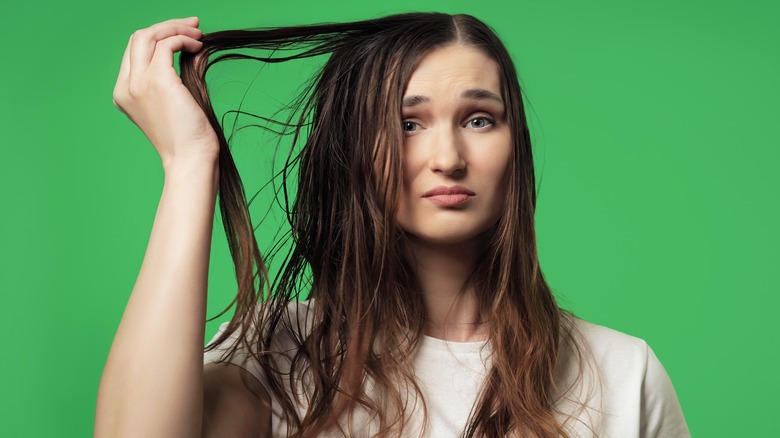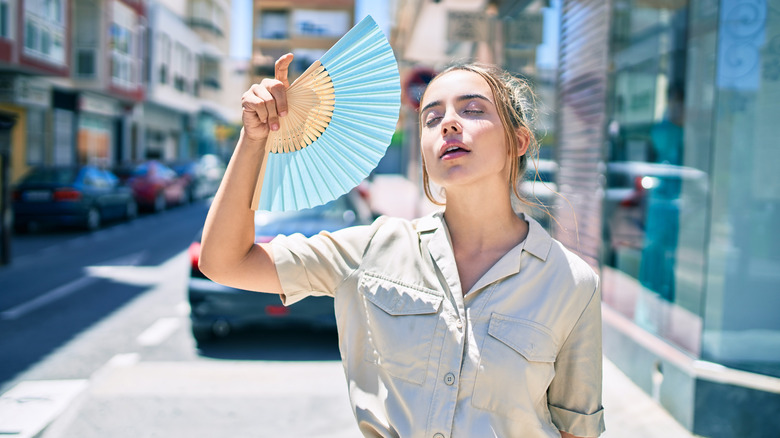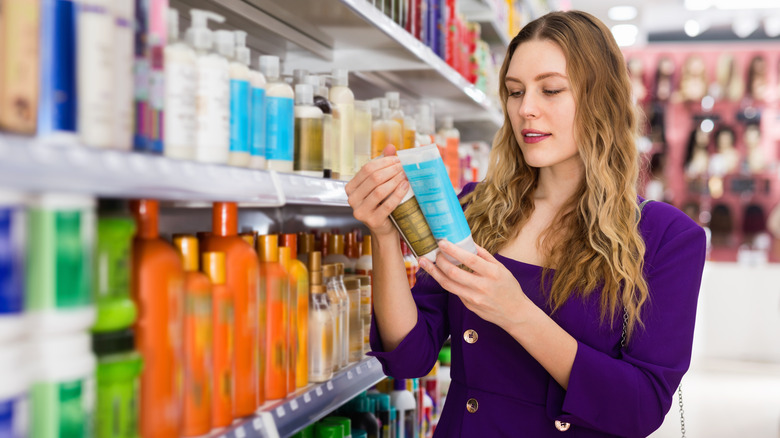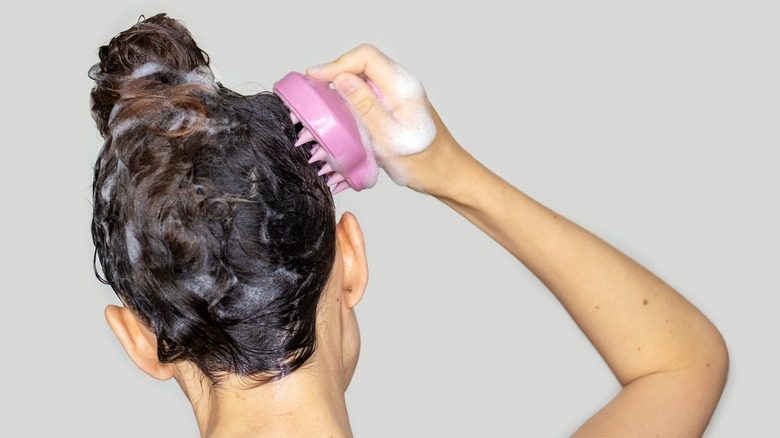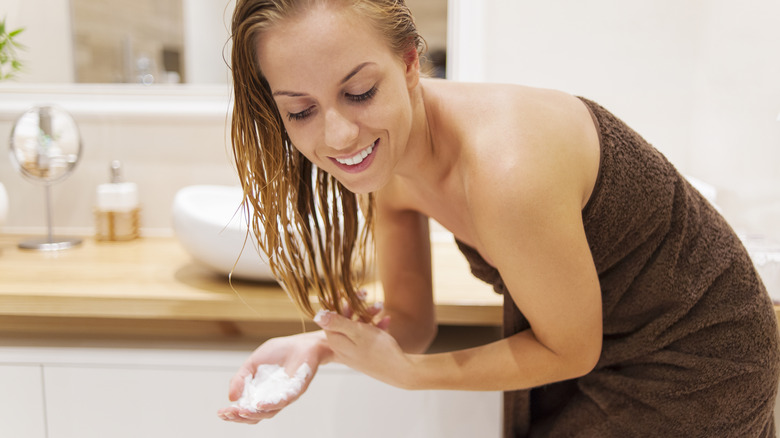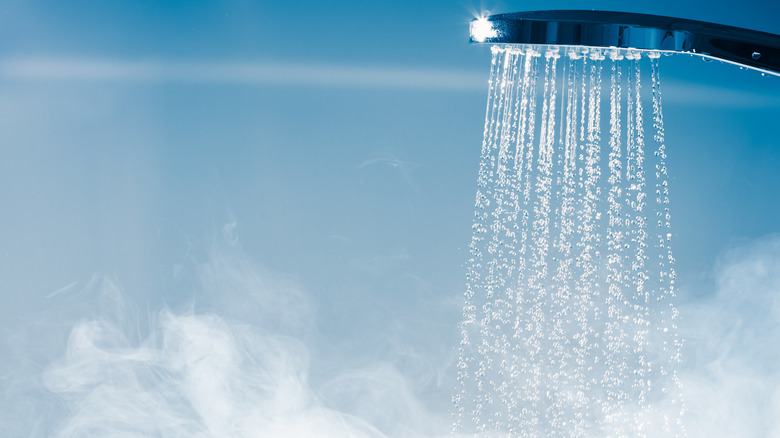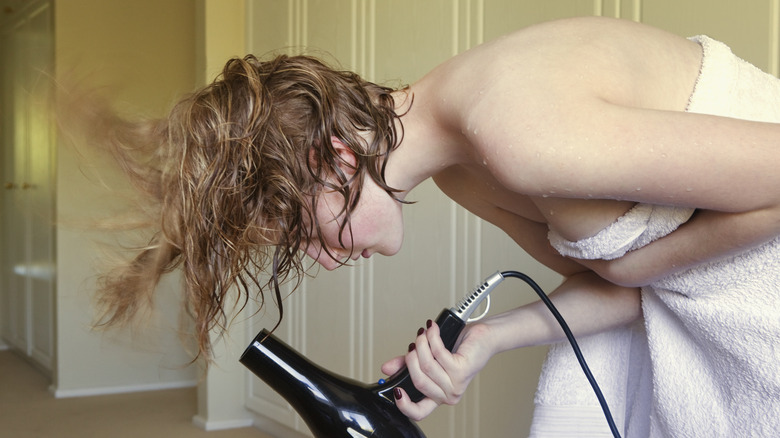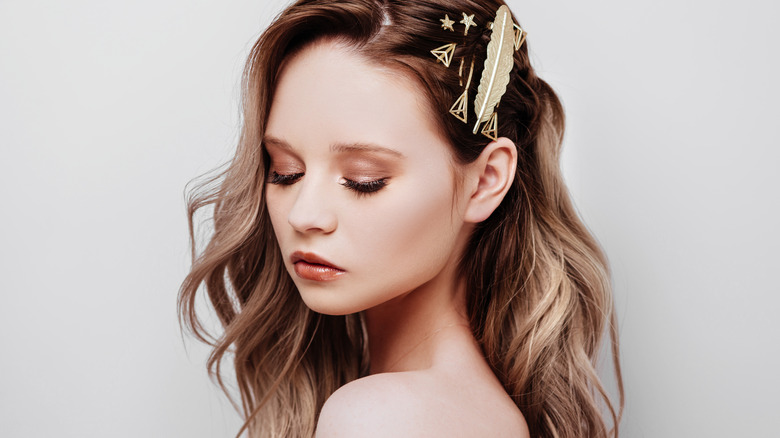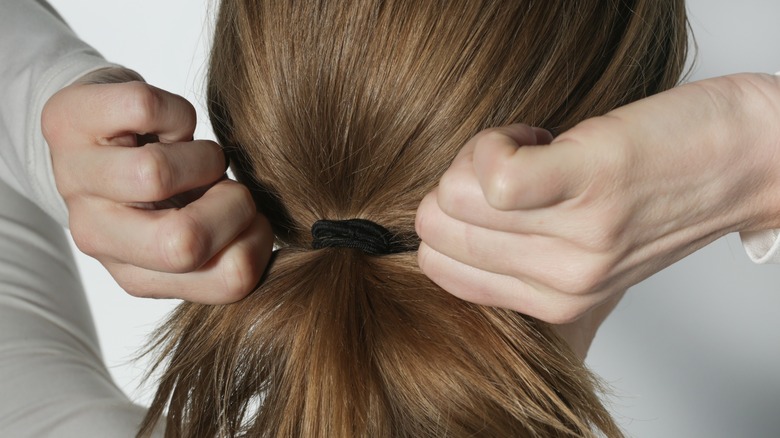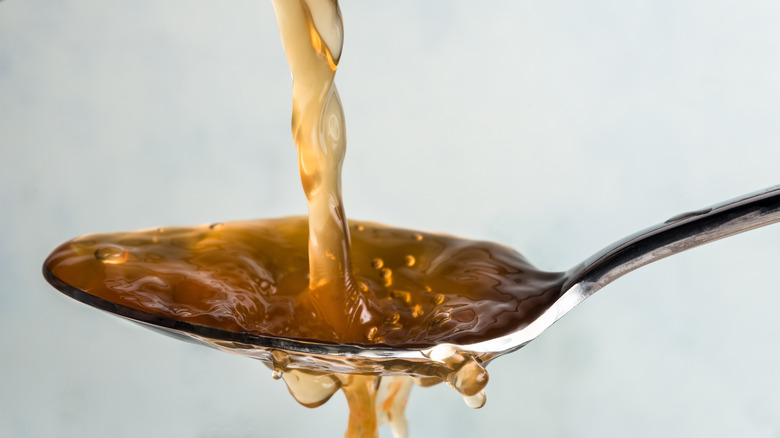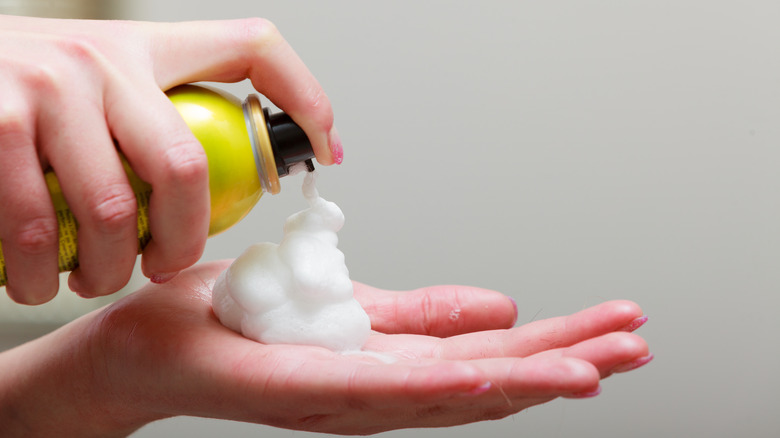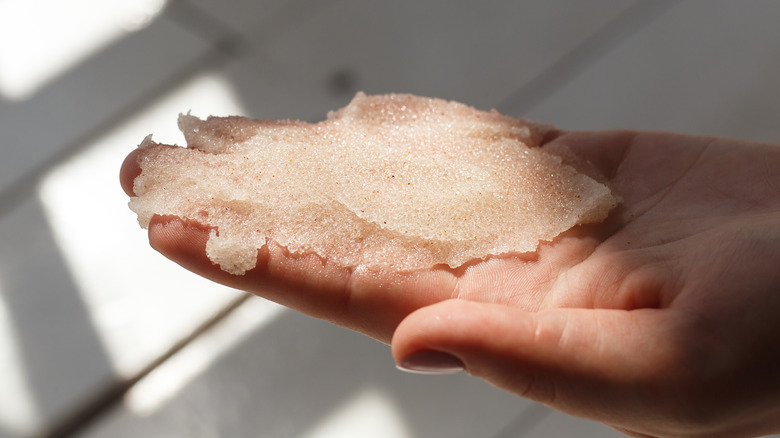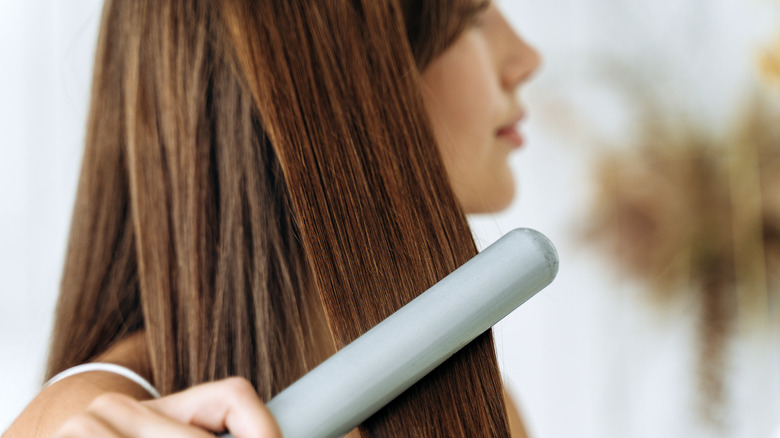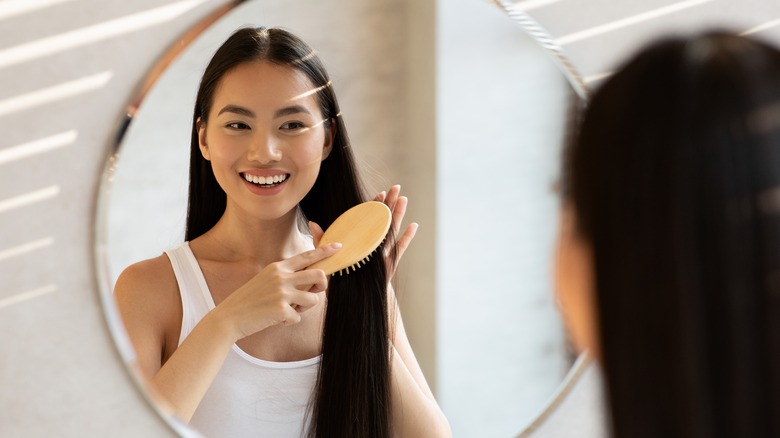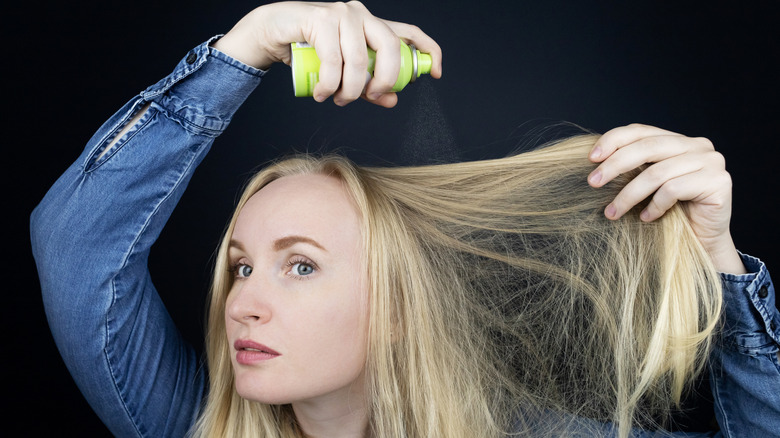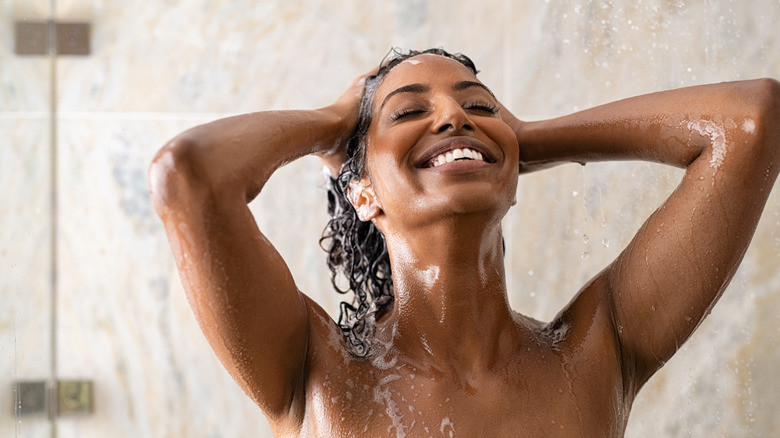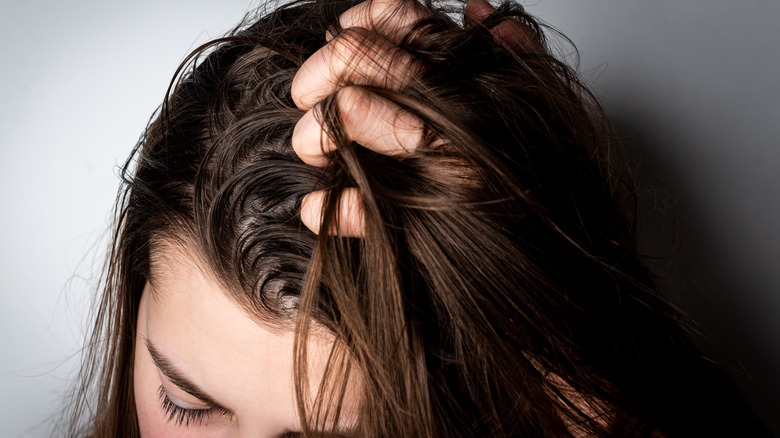The Best Tricks For Dealing With Oily Hair
Those with oily hair know how annoying it is to wash your hair in the morning only to have it look dirty by the end of the day. "Greasy hair is the result of overactive sebaceous glands when they are producing too much sebum," stylist Linda de Zeeuw tells Byrdie. "Although sebum is good for the hair, too much can make your hair look slick and greasy."
While it's hard to find one tip that will work for everyone (after all, scalps are different from person to person), we have rounded up some tricks that are worth trying if you struggle with hair that gets too greasy too quickly. Per Pure Sense, an untreated oily scalp can get worse over time and eventually lead to hair loss, which is why greasy hair isn't a problem one should overlook. Luckily, you can make simple and easy changes to your haircare routine to help your scalp get back to its normal oil production.
Wash your hair more often in the warmer months
If you have hair that tends to get oily quickly, you've probably noticed that the intensity of the greasiness changes with the seasons. In the warmer months, your hair might be a tad bit greasier than in the winter. "Many people find greasiness is worse in the warmer months," Dominic Roach, Butchers Salon's Creative Director of Color, tells Glamour. "With rising body temperatures, sweating is on the increase, allowing sweat to mix with the sebum on the scalp, hence spreading more greasiness."
Trichologist Kay Fitzgerald explained to ABC that sweat enables the oil to travel further down your hair. Apart from this, she also pointed out that the sebaceous glands tend to be more active the higher our body temperature is. According to research published in StatPearls, the sebaceous glands provide 90% of our skin's surface lipids as they produce an oily substance known as sebum (via National Library of Medicine).
Avoid harsh shampoos that claim to add gloss or shine
If you've been using shampoos that claim to give your hair gloss and shine, it's time to swap those out. "They may all just be coating the hair in a fine film, which is good for what it states, but not good if your hair is prone to looking greasy," trichologist and founder of Hairmedics Iain Sallis tells Glamour. "The coating will add to the oil produced and cause the hair to become dull and oily looking."
Apart from picking shampoos that add shine, it would help if you avoided any harsh shampoos, as those will do more harm than good. "Harsh shampoos strip the hair and scalp of natural oils, particularly if they have a basic pH," board-certified dermatologist Mona Gohara tells Allure. "They open what should be a closed hair cuticle, [then] water evaporates out, and dryness follows. The oil glands don't like that this is happening and kick into overdrive." A harsh shampoo usually contains ingredients like sulfates, silicones, and sodium chloride (via B.O.B. Affordable Luxury Hairdressing).
Switch to a clarifying shampoo with the right pH
Numerous shampoos are advertised as being made for oily hair — but you shouldn't always trust labels like that. Instead, pick a clarifying shampoo, as those can help eliminate any buildup on your hair. "Use a purifying shampoo on a weekly basis and follow with your preferred shampoo and conditioner to best suit your hair type," Dominic Roach, Butchers Salon's Creative Director of Color, tells Glamour. Trichologist and cosmetologist Sophia Emmanuel adds it is crucial to pick a shampoo that "has a pH of 5.5 or less" (via Byrdie). She says that selecting a shampoo with the proper pH will prevent drying the hair out, and that way, the scalp won't go into an oil overproduction mode.
Apart from picking the right shampoo, it is also essential to not use too much of it. "When washing the hair, it is very important not to use too much shampoo as it can become heavy on the hair," stylist Jack Merrick Thirlway tells Glamour. "Generally speaking, a 10 pence piece amount of product is sufficient — and two quick washes rather than one long wash will work better."
Once you know what to look for when you're picking shampoo for oily hair, ensuring you massage your scalp correctly while shampooing is also very important. A scalp massager brush can help you get that perfect lather.
Apply conditioner sparingly to the ends of your hair only
Per Function of Beauty, everyone should use conditioner, regardless of hair type because shampoo can't provide moisture and nourishment. However, don't apply it too close to your roots if you have oily hair. "You should apply conditioner from mid-strands to ends. This helps to avoid any buildup and/or excess sebum (oil) production," hair doctor Kalin Spooner tells Mane Addicts. "A healthy scalp naturally has a layer of sebum, so the hair closest to the scalp is the first place oil appears." According to Spooner, while applying conditioner to your hair roots won't damage your hair, it will weigh it down and make it look flat and limp. It can also cause buildup.
You may also be able to lessen the number of times you conditioner your hair. Danusia Wnek, a GH Beauty Lab chemist, says "if you have oily hair, you may not need to always condition your hair" (via Good Housekeeping). Because of this, it is essential that you always examine your hair before washing it to determine what it actually needs.
Don't wash your hair with water that is too hot
According to Health Shots, washing your hair with hot water can cause hair dryness, increased hair loss, scalp inflammation, and dandruff because it is more likely to remove the natural oils from your scalp. Instead, you should wash your hair with warm water. "Warmer temperature will ensure a gentle but thorough cleansing action of the shampoo to remove oil/sebum and product from the hair," Liz Phillips, trichologist at the New York Philip Kingsley Clinic, tells Mane Addicts. "This is particularly important if the scalp produces a lot of oil and the hair is fine."
Rinsing with colder water will help your conditioner work better and make your hair appear more glossy. "Be sure to cool the water for the last rinse to add shine," celebrity hairstylist Paul Percival tells Glamour. "A blast of cold water once it's washed will also help the scalp and regulate blood flow."
Ditch the hair dryer whenever you can
According to Laura Polko, a Los Angeles-based celebrity hairstylist, "blow-drying too much can also cause your hair to produce excess grease, so try letting your hair air-dry instead" (via Byrdie). Using a light texture spray or mousse can make your hair appear styled, even if you just let it dry naturally.
Of course, most people have those days when they need to blow dry their hair. Celebrity hairstylist Paul Edmonds has some tips on using a hairdryer if your hair is on the oilier side. "While using the hair dryer, rough dry upside down to add volume without applying excessive heat to the roots, which strips hair of oil, tricking the scalp into thinking it needs more and giving oil production a boost," he tells Women's Health. Another pro tip? If you have the option of choosing a lower-heat setting (or a cold one), always use that instead of the high-heat one.
Using hair accessories will make your hair get greasy quicker
Any hair accessories you put on your hair can transfer dirt and oil to it — or press your hair closer to your scalp, which makes the oil transfer easier. "Sunglasses pushed back onto the top of the head help transfer oil and grease. So do sun accessories like hats, which make the roots flatter and greasier," Dominic Roach, Butchers Salon's Creative Director of Color, tells Glamour.
Of course, you can still use hair accessories. In fact, hair accessories are great for when your hair is already a bit oily and you're trying to style it. Hair accessories are your best friend on day two or there, from headbands for a sleek look to hair clips to prevent your hair from getting that separated oily look. But if you want to keep your hair looking clean for as long as possible, avoid them on day one.
Whenever you can, put your hair up
Another way your hair can get greasier is if you're touching it a lot or if it is touching your face. Since our skin naturally has oils on it, those can easily get transferred to your hair. "Dirt from your hands can accumulate in the hair whenever you touch it," Butchers Salon's Creative Director of Color Dominic Roach reveals to Glamour. "Putting your hair in a loose bun or braid will keep it away from an oily face or sweaty neck."
However, if you are putting your hair up, make sure that it isn't a tight updo. Any hairstyle that tightly holds your hair in place causes damage in the form of hair breakage and fallout (via Everyday Health). Apart from this, try switching between the updos you are regularly wearing. "When you wear your hair in the same ponytail every day, you're adding stress to the same spot over and over and over again, and eventually that's going to cause your hair to snap and break off at the base of the ponytail," Jenna Marie Shafe, Lead Pro Educator for Amika and Session hairstylist, tells Byrdie.
Consider rinsing your hair with apple cider vinegar
If you've ever dabbled into the world of homemade remedies for hair problems, you've undoubtedly heard of the numerous benefits of apple cider vinegar. "Apple cider vinegar rinses are really truly about removing buildup of products, and they make the hair really clean," stylist Jo Blackwell-Preston, the founder and master stylist at Dop Dop Salon, tells Byrdie. Apple cider vinegar rinses are beneficial for any hair type, but they are especially great if you struggle with getting your hair clean and you always feel like there is a layer of buildup on your hair, even after you've just washed it.
"Apple cider vinegar coats the cuticle, leaving the hair soft and shiny," celebrity colorist Denis de Souza tells Byrdie. "It also helps to strengthen your hair by closing the cuticles and the hair shaft." Per Healthline, all you have to do is mix 2 to 4 tablespoons of apple cider vinegar with 16 ounces of water. You use the mixture as your last step, meaning you rinse your hair with it after you've already rinsed out your shampoo and conditioner. After letting it sit on your hair for a minute or two, you rinse it out with cold water.
Avoid applying products to your roots unless it's hair mousse
If you have oily hair, be aware that haircare products can easily cause buildup — especially on your roots. This is why when you're styling your hair, you should avoid using any hair creams, gels, or sprays too close to your roots.
Of course, if you are trying to get more volume, a mousse can help you, but apply it only sparingly. "The only product you ever want to put on your roots when your hair is damp is a mousse or a root lifter before blow-drying," Allison Friedman, senior stylist at the Warren-Tricomi Salon, tells Byrdie. Per Schwarzkopf, alcohol-based setting mousse can be used to absorb some of that oil on second or third-day hair. All you have to do is apply it to your roots in small amounts — remember you can always add more — until the oil is absorbed.
Don't be a stranger to scalp exfoliation
Per Healthline, hair experts claim that the best way to help your hair become and maintain healthy is to regularly exfoliate your scalp — an area that many forget about. For this, you can use a physical or chemical exfoliant that will help remove dead skin, as well as product and oil buildup from the scalp and roots."I like using scalp scrubs to remove any product buildup and oil," Los Angeles-based celebrity hairstylist Laura Polko tells Bydrie. "My favorite is the clarifying scrub from NatureLab Tokyo. It's gentle yet effective and leaves your scalp feeling clean and healthy."
Devin Graciano, professional hairstylist and co-founder of Goldie Locks, tells Shape that he recommends chemical exfoliants. "Products with AHAs or BHAs are known to remove dead skin, unclog hair follicles, and remove excess oil," he says. However, keep in mind that you should only exfoliate your scalp one to two times a week (via Healthline).
Don't straighten your hair (unless you have to)
Those with greasy hair have probably already noticed how it tends to look even more oily once they straighten it. While this, at first, doesn't seem to make sense, there is a very logical explanation as to why. "If you straighten your hair, it will lie closer to the scalp, coming into contact with more oil and appearing greasier," dermatologic surgeon Sejal Shah tells Good Housekeeping. Apart from this, it is also your straightener that can make it dirty. "If your styling tools are dirty, you can transfer oils and dirt to the hair," Shah adds.
You can easily clean your hair straightener (or any heat styling tool) with cotton balls dipped in rubbing alcohol or baking soda paste (via Apartment Therapy). A toothbrush can help with really stubborn gunk. Remember to always ensure that your heat styling device is cold before attempting to clean it.
Avoid over-brushing your hair and wash your hairbrush regularly
Everyone knows that brushing your hair is important as it helps massage the scalp and distribute your hair's natural oils. "Sebaceous glands located in your hair follicles produce natural oils that help lubricate your scalp," celebrity hairstylist Vincent De Marco tells Healthline. "When you brush your hair properly, it helps distribute these natural, healthy oils from the roots of your hairs to the ends, giving them a natural shine." However, if you move the oil too much down your hair, your scalp will produce even more. Sejal Shah, M.D. tells Good Housekeeping that "over-brushing can stimulate more oil production," which is why you should only do it when necessary. Per Healthline, experts recommend that you brush your hair no more than once or twice a day.
Apart from brushing too much, you can also make your hair appear dirtier by brushing with a dirty hairbrush. "The collection of excess hair and product grime can accumulate on the brush, [and] become the perfect breeding ground for bacteria and yeast," Kerry E. Yates, trichologist and the founder of Colour Collective, tells Byrdie.
Dry shampoo can quickly take your hair from greasy to clean-looking
Dry shampoo is definitely a staple product for anyone who has greasy hair. "Add it to your root area to absorb excess oils, sweat, and impurities," Butchers Salon's Creative Director of Color Dominic Roach tells Glamour. "It can also create volume and texture in yesterday's hairdo."
You don't have to use dry shampoo only when your hair is visibly oily. If you want to prevent greasiness, you can also apply it to clean hair. "I apply some dry shampoo directly to my roots after a fresh blowout so that, as the hours go on and your scalp starts to produce oil, the dry shampoo will start working immediately to combat that oil," Allison Friedman, senior stylist at the Warren-Tricomi Salon, tells Byrdie. In fact, you can also apply dry shampoo on wet hair, as some claim that this helps them get an extra day or two between washes. However, be mindful of what dry shampoo you use. Amid massive recalls, there are only certain dry shampoos that are safe to use.
Don't wash your hair every day
A tale as old as time that anyone with oily hair has heard numerous times is to simply wash your hair less often, and it will be less greasy. While this doesn't always work (since there is a variety of reasons why one's scalp might be producing too much oil), for a lot of people, it does wonders — and experts explain why. "If you start washing your hair every day, your scalp feels like it has to overproduce sebum. You end up in a vicious cycle of feeling like you need to wash your hair every day," Paul Percival, celebrity hairstylist and Co-Founder of Percy & Reed, tells Glamour.
However, it is going to take some time before your scalp realizes that it doesn't need to produce as much oil anymore, which is why most people give up on the hair training method. "If you normally wash your hair every day, it will take time to adjust to just washing it every few days, so you may have to tie it back or wear an alice band for the in-between days," Mark Woolley, founder of Electric Hair, tells Glamour. "However, once your hair adjusts, you will notice a dramatic difference by not washing it every day."
Find out why your hair is so oily
All of these tips can help your hair, but the best way to make it less greasy is by finding out just why it gets so greasy in the first place. Per Goldie Locks, it can also be factors like your hormones or your genetics that cause your oil glands to overproduce oil.
The List notes the importance of finding out why your hair gets greasy so quickly and what habits might lead to it before you look for solutions and improvements. While your hairstylist can surely give you some tips (after all, they've seen plenty of scalps), a dermatologist can properly diagnose your scalp and give you more insight into what you might be doing wrong when it comes to your haircare routine. Of course, you can still always try the tips we suggested — but if none of them help, it's best to get an expert's opinion.
